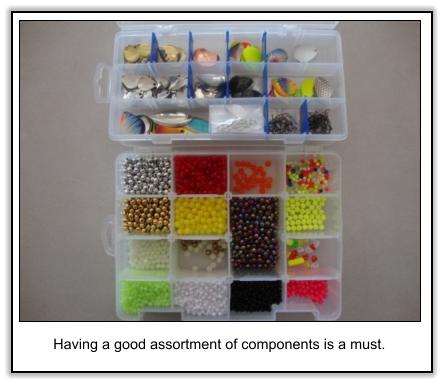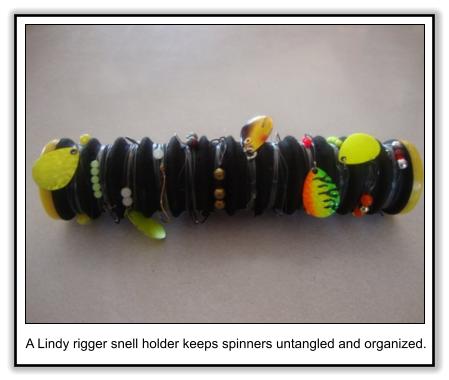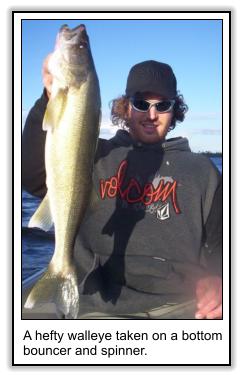|
Walleye Spinners 101
By: Tyler Dunn
Spinners are without a doubt one of the top
producing walleye baits of all time. Spring,
summer or fall spinners can be effective during
any of the soft-water months. The following tips
will help you not only tie your own custom rigs
but catch more walleye on the all-mighty
spinner.

Tie Your Own
I don’t know any serious walleye
anglers who buy spinner rigs from a big name
store such as Canadian Tire or Wal-Mart. Some do
still purchase rigs off local tackle stores but
most will agree that homemade, hand tied
spinners can’t be beat. The simple components
needed for tying spinners are line, beads,
blades, hooks, clevises and barrel swivels.
These are extremely cheap and are widely
available at most tackle stores in a mind
numbing variety of colours and sizes. The most
expensive component will be the line you decide
to use. I prefer to use Seaguar’s 100%
fluorocarbon leader material in 10 or 12 pound
test. A good substitute for leader material is
any fluorocarbon coated line. Fluorocarbon is
much more abrasion resistant compared to mono
filament and becomes virtually invisible beneath
the water. Follow the steps below and tie your
own spinners.
Step 1 - 18 – 60 inch piece of
100% fluorocarbon leader material
Step 2 - Tie barrel swivel to
one end of the line
Step 3 - Place 2-3 beads on
line
Step 4 - Place the blade on the
clevis and feed the line through the clevis.
Make sure the rounded side of blade is facing
towards the swivel and the cupped side has
nothing below yet
Step 5 - Place 2-6 beads on
line
Step 6 - Snell an octopus hook
and leave a tag length sufficient enough to tie
on another hook
Step 7 – Snell the final
octopus hook and complete the spinner by
trimming the tag end.
Deep Spinner Rigging
Bottom bouncers are one of the most
efficient ways to present a spinner. Using a
bouncer can be difficult during the beginning
stages but with some persistence you will
quickly learn how to constantly present the
perfect bounce. Bottom bouncers are V-shaped
pieces of wire with a lead sinker moulded at one
end and a swivel at the other intended for your
spinner. You’re mainline which should be heavier
line then the line on your spinners is attached
at the bend in the wire. The reason for using a
heavier mainline is to prevent from losing your
bottom bouncers when your spinners get hung up.
The spinner will break but your bottom bouncer
will be saved. When I do get a bouncer snagged
on something I immediately free spool my reel,
giving my line a bit of slack and snap the rod
quickly. If this doesn’t work simply go over the
snag in the opposite direction you came from and
usually the bouncer will easily pop free. Having
too much line out is going to result in a lot
more snags rather than not having enough line
out. In order to keep the least amount of line
out but enough to keep bottom contact every so
often, use the rule of 1 oz of weight for every
10 feet of water your fishing. Another easy way
to determine if you have too much line out is
the angle at which your line is entering the
water. Anything more than 45 degrees will you
will be dragging bottom too much and a snag is
inevitable in rocky or woody areas.

Shallow Spinner Rigging
Spinners are not just presented well on
a bottom bouncer but shallow weed bed walleyes
have a soft spot for them too. A spinner,
trolled on a long line just over top of a weed
bed can entice walleyes throughout the entire
year. Split shots or egg sinkers are great
weight options for getting a spinner in the
strike zone. The strike zone would be just above
the fish, ticking just the tops of the weeds.
Spinners are usually pulled at speeds between of
2 mph and lower but often when trying to cover a
huge amount of water speeds of 2+ are not
uncommon in large bodies of water such as any
part of the Great Lakes. walleyes throughout the entire
year. Split shots or egg sinkers are great
weight options for getting a spinner in the
strike zone. The strike zone would be just above
the fish, ticking just the tops of the weeds.
Spinners are usually pulled at speeds between of
2 mph and lower but often when trying to cover a
huge amount of water speeds of 2+ are not
uncommon in large bodies of water such as any
part of the Great Lakes.
Gear
Rods in the 7-8 foot length are ideal
unless longer rods are needed for presenting
multiple rods. Bottom bouncer rods require an
extremely soft tip. Companies do offer many
technique specific rods designed for bottom
bouncing but a great substitute for them is a
medium-heavy crank bait rod. These rods are
often E-glass or fibreglass rods that literally
have tips that absorb everything which is needed
for deep water spinner rigging. As far as line,
I already mentioned that I always spool my reel
with heavier line then I have on my spinners to
prevent losing bottom bouncers to break-offs.
|